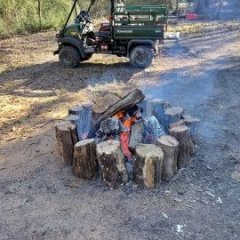-
Posts
829 -
Joined
-
Last visited
-
Days Won
153
Content Type
Profiles
Events
Forums
Gallery
Downloads
Community Map
Everything posted by kenfain
-
If you'll be spending a lot of time in the mud. You might want to think about one that has the six wheels, like the John Deere gator. Most of the top brands will work great in the mud, but they'll chew up a lot of ground doing it, when loaded. Independent suspension will help with a lot of the problems of traction. Also allowing larger, more aggressive tires to be added. But a buggy like that isn't ideal for towing, or hauling a load. What I'm saying is that you really need to fully understand the actual use it'll get. If it's truly intended for something like a working, muddy, dairy farm. The 6 wheel gator, or Polaris Ranger is popular there. I'd certainly check to see what Kubota has available. If you just need to hunt pigs in the back forty, then I'd suggest something small, with upgradeable power. They made a million Yamaha rhinos. Must be something to that. But as Travis has said, parts availability is key. So that means a well known brand. Also, factory authorized service can be handy if you don't work on it. If you're just fishing for a specific brand to begin your search. I'd check out the local tractor dealer. I know that Deere, and Kubota both have a SxS. Maybe the others have something? But this suggestion comes from the parts availability standpoint. I have a kawasaki mule, and dealerships are opening, and closing so fast, I have to make sure they're still there before making the drive. Most parts are dealer parts, and some things are best done in person. One last thing, you definitely want to consider a diesel. Gas is good for tearing up the grass, and mud, and flying over the berms. But when it comes to slow deliberate power, diesel is the way to go! That may dramatically change your options.
-
Can Am doesn't make belts. They're just having the belt manufacturer put their name on it. Gates makes most of those belts. Either way, you can't go wrong with a name brand belt. If the price is the same, go with the CanAm. You can't go wrong with OEM either, and the fit is almost guaranteed.
-

610 mule fouls plugs after about 1 hr run time
kenfain replied to bjones's topic in Kawasaki UTV SxS Forum
I'd try the maximum factory spec. Of .0059. Maybe you can lose the tick, and minimize fouling. Maybe even try .0060, or .006. If you don't like the ticking( me either) maybe you can split the difference. You'll probably still have fouling. Maybe that can be addressed by other means. Like leaning the mix, or the hotter plugs. -

610 mule fouls plugs after about 1 hr run time
kenfain replied to bjones's topic in Kawasaki UTV SxS Forum
Yeah, I'd have to think that the valve adjustment is the likely suspect. I guess the real question would be. Why does the fouling get worse, when the valves are properly adjusted? I'd probably lean out the air/fuel a bit. See if it helps. -
If it's already converted, then that certainly changes things. Some UTV brands, and models come with a big Honda, horizontal shaft engine, mounted just as you describe. Don't know about the chain drive though. Can't remember exactly which ones I've seen it on either. But it definitely wasn't a Honda. That was what caught my attention. I'm thinking it was at Tractor Supply Co. Anyway, one of those could possibly answer some questions about what the options might be.
-
I'm not talking about the pamphlet, that comes with a piece of equipment. I'm talking about the mechanics desk reference that the factory mechanic, at the dealership, would use to reference any unfamiliar item, or procedure. This manual would demonstrate the complete disassembly, procedure. Along with the reassembly if it's different. For the entire machine. It's a large book! These things are typically called the shop service manual. You have to ask about it SPECIFICALLY. Because most people don't care enough to ask, they're not that popular. That is, until ten or twelve years later, when they're obsolete, and no longer available. These days they're probably a pdf. You'd want to download that, and print, place in a notebook. So that when everyone else can't find it. You have it. I get one for EVERY piece of equipment, large, or small. Because new stuff rarely breaks down, if it's quality stuff. But when it does, there likely isn't any shop manual available.
-

2019 Can Am Maverick Trail 800 Bearing Greaser
kenfain replied to UPLou's topic in Can-Am BRP UTV SxS Forum
Have you tried Google? It showed several likely candidates. Is that not what you're looking for? If not you'll need to give more specifics. -
Travis has given you probably your best lead. I'd strongly advise you to take it a step further, and request to purchase a shop service manual. It would be EXTREMELY helpful to assist you through normal maintenance interval service. But what's more important, is it'll be impossible to find, when you really need it for the inevitable. Eventually all machines break, but you'll be better prepared when this one does. Besides, it'll sure as heck answer the question you've put on the table here. Welcome to the forum!
-

610 mule fouls plugs after about 1 hr run time
kenfain replied to bjones's topic in Kawasaki UTV SxS Forum
What does the exhaust look, & smell like? Unburned fuel? Blowby? Any smoke? -
I'm with Travis. Just because it could be done, doesn't mean that it should. I believe that "all in", the price would be substantially more than a rebuild. If there were a major power gain, it might be worthwhile, but I don't see that happening. If anything, I'd look at refitting a larger stock motor. Like the diesel that was offered on the 3010. Where you'd have the option of do it yourself fab, or off the shelf parts. Things such as motor mounts. But personally, I wouldn't even go that far. I'd just rebuild, or replace the existing motor.
-
They have electric powered hydraulic pumps. Kinda like how a power steering makes hydraulic power, using a pulley off the engine. These would use an electric motor to accomplish the same thing. But you still need a hydraulic rack and pinion. I'd look for a vehicle that has the same width, as measured hub to hub. There's plenty of vehicles that have power steering. But mounting it will still require lots of modification, as well as a significant cost. Most of the cost would be in acquiring the rack, since a utv salvage yard will be difficult to impossible to find. The research of finding a suitable sized rack will be a daunting task. But you might get lucky, since being real close would probably work just fine. But the fabrication will need to be perfect, if its gonna drive & ride right. Give WCF a call, maybe he's got a simple solution.
-

Yamaha wolverine side by side rear axle
kenfain replied to Matthew Zeller's topic in Yamaha UTV SxS Forum
The specs for the 2018 wolverine, say it has a three way, on demand locking differential. As Travis has said it's surprising for it to not have that as stock. Are you certain that it's not a mistake? Is it new, with an owners manual? If its determined that it absolutely has a full time locked differential. There's a possibility that you could easily swap out a locker mechanism from a different model wolverine. -

2006 Kawasaki Mule 3010 trans ONE wheel turned inwards
kenfain replied to jgreg's topic in Kawasaki UTV SxS Forum
You'll probably need to get that wheel off the ground. Then try grabbing the tire, and manually moving it through the turn it would make, if you were using the steering wheel. Left/right etc. Then look to see where its broke. It should be quickly obvious when you see something flopping around. If not, then my money is on the inner tie rod. Although it could be the rack. But since its just one side, that inner tie rod seems most likely. You might have to pull that boot to be certain. Since that inner rod is mostly hidden by the boot. Don't damage that boot, and try not to break the tie that's holding it if possible. Since if it's anything like a car, those ties take a special, expensive, never used again tool, to replace them. You'll end up using zip ties on em, or hose clamps. That just isn't the same kind of seal. See if you can gently slide those off. Preserving the boot is really the hardest part of the job. Inner tie rods are definitely a do it yourself job. -
That's a really nice fit, they look good. Hope you had a happy birthday Travis.
-
It looks like a solid choice for what you have in mind. Unfortunately I can't give any feedback on the newer models, since mine is an 05 diesel. Other than replacing the battery several years ago, it's never given a single hiccup. I would however, highly recommend the diesel motor. Mine is a beast, it has out pulled my 4wd New Holland 27 hp. tractor! Of course that was an isolated incident, and I'd be very surprised if it did it again. But I've never had any power, or traction issues, and my use is around the farm also. It's a tough, reliable little machine. Mine has a lift kit, and side bed rails, as well as a couple other things, to make it more useful. The availability of aftermarket add ons like these were the main reason why I chose the mule over something like the Kubota. If the Polaris Ranger hadn't had automatic engagement on their 4wd, I might've went that way. I just don't like equipment that does my thinking for me. But the bottom line is; get something that has a good dealer support in your area. Good aftermarket parts availability, so you can tailor it to your needs. There's lots of buggies out there for joy riding, and they're great for that purpose. They've got the independent suspension, high lift, and powerful motors. But you'd probably be happier with a clunky old school straight axle machine. Those things are purpose built for work.
-

ranger XP 1000 HIghlifter Or Honda Pioneer 1000LE?
kenfain replied to Tony Rea's topic in UTV General Discussion
Hey Tony. Just a quick look at the two, looks like the Ranger is a bigger machine. At over 1500 lbs. It likely won't be much for mud, or creeks. But if you're looking for a firewood hauler, it looks like it's on point. Most of these machines aren't as versatile as the manufacturers would have you believe. Unlike a truck, typically you can't infinitely upgrade. Eventually creating a bullet proof mud buggy, that can haul a load of wood through a creek. Instead, it's typically a serious trade off. You have to decide what you'll do with it the most. If it's mostly work, then get the big one. A set of mud tires, and a winch, will get you most places you'll want to go. If it's mostly for trails, and mud, but needs to be able to do some hauling also. Then make sure you pick a model that has lots of wheel travel space in the fender well. Plenty of available upgrades, like lift kits, tires, maybe a power upgrade as well. It'll still be good for some light duty work. It does have a bed on it after all. But make no mistake, those tiny axles, won't take a lot of torque. Any more than that big machine will float on top of the mud. -
Howdy back at ya Leon! Welcome to the forum. Congratulations on scoring that new to you TERYX. Is it stock? Any plans on upgrades?
-
Just a guess, but I'd suspect that you'd be better off using a utv power rack n pinion. Maybe off an older Kubota 9000. Either way you're gonna have to do some fabrication. If Kioti has a power steering model, you might get lucky.
-
That's a good tip, even for a car. I'm a member on several car forums, and it's a common problem. Sometimes it just causes overall mahem, nothing specific, just electrical gremlins. Ends up being a faulty ground connection.
-

Bad Boy Stampede 900 Seat Belt By-Pass
kenfain replied to Bruce A. Revelle's topic in Textron Off Road UTV SxS Forum
Is this something that could be solved by buckling the belt behind the driver? I just hate all the lawsuit driven safety measures. My 2005 mule goes 25 mph in high gear. Still has a seat belt though, with the original rubber band on it. Rarely goes over 15 mph. Never saw the need. The good news is, that most useless safety measures can be overridden pretty easily. Typically just a simple sensor, that can be overridden by a jumper wire. Least ways that's how it works on my rider mowers. It all depends on what the manufacturer has put in, and how serious they are with it. -
Patience Travis...104° with 96% humidity is coming. Just enjoy this pre summer weather. Of course, in Texas, summer takes up three seasons!
-
It really sounds like a fuel pressure problem. Don't know if it's a bad pump or just weak, or the wrong pump completely. But the pressure should be consistent, and in the right pressure as stock. The fact that you've got to turn the key on and off a few times seems to indicate that something isn't right there. With the Ford Ranger, that's a dead giveaway that the pump is bad. Check voltage, and amp draw, if possible. I'm assuming that there's no blockage on any of the fuel lines, or filter. YouTube can help you clean the injectors, if you think they're a problem. But I think the pressure is a clue to the problem. As far as swapping fuel pump assemblies, I doubt it would solve the problem unless it's the same motor. Which I doubt. My experience comes from a Ford Ranger, not a Polaris, so its only my opinion, and worth exactly what you paid for it.
-
Sounds like you've got air in the system.
- 1 reply
-
- 2
-

-

-
Don't know if this will help, but it looked interesting, and possibly relevant. If you end up finding that the fuel pump is the problem. I'm not sure what obstacle the poster ran into that made him go this way, instead of an actual repair. But sometimes there's little choice. But until we know what the problem is, this is a cheap alternative, and a quick fix. If it's a stuck float, a fuel cut off is always a good idea anyway. And it'll stop that particular issue. Although it won't actually fix the real problem, it'll stop the unwanted gas.
-
If there's enough slack for the push rod to spin, then it can take some tightening with no problem. So its worth a try. Just be mindful of the original settings. You don't want to over tighten. A bent push rod would be bad. Just as long as there's the proper tolerance somewhere around the top. Just rock it back and forth, and try to push the feeler guage in while doing it.






